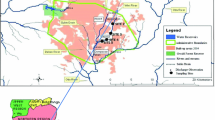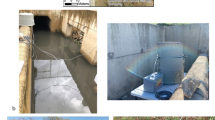Abstract
Extreme bather densities can have significant impacts on water quality in treated and untreated waters. In this case study, water quality was monitored throughout an annual event known as the “Mirror Lake Jump,” in which thousands of ‘jumpers’ briefly entered a small lake fed by a municipal water supply, which provided an exceptional opportunity to track the water quality change due to extreme bather levels in a short period of time. Microbial water quality was monitored in conjunction with enumerating bathers, mostly collegians, fully exposing their body to the water, which occurred in an urban pond (2600 m3) on a university campus in Ohio, U.S.A. Microbial densities were determined from water samples collected before, during, and after the event. Quantification of fecal indicator bacteria (Escherichia coli, enterococci) and genetic markers reflecting fecal contamination (gyrB, HuBac, tetQ, ent23) was performed using culture-based methods and quantitative polymerase chain reaction (qPCR), respectively. Significant correlations (p < 0.05) were observed between the total number of jumpers and levels of turbidity, enterococci, E. coli, a human-associated marker (HuBac), and an antibiotic resistance marker (tetQ). Among bacteriological parameters, the tetQ marker presented the most significant time-associated trend (p = 0.01). Overall, the fecal indicator bacteria (FIB) densities observed during this extreme event ultimately exceeded water quality action values by an order of magnitude. Bather fecal shedding and resuspension of FIB and antibiotic-resistant bacteria likely occurred during the Mirror Lake Jump and future studies related to bather density impacts on microbial water quality are recommended for improving understanding related to potential public health impacts.



Similar content being viewed by others
References
Alm EW, Burke J, Hagan E (2006) Persistence and potential growth of the fecal indicator bacteria, Escherichia, in Shoreline Sand at Lake Huron. J Great Lakes Res 32:401–405. doi:10.3394/0380-1330(2006)32[401:PAPGOT]2.0.CO;2
Bryan A, Shapir N, Sadowsky MJ (2004) Frequency and distribution of tetracycline resistance genes in genetically diverse, nonselected, and nonclinical Escherichia coli strains isolated from diverse human and animal sources. Appl Environ Microbiol 70(4):2503–2507. doi:10.1128/AEM.70.4.2503-2507.2004
Byappanahalli M, Fowler M, Shively D, Whitman D (2003) Ubiquity and persistence of Escherichia coli in a Midwestern coastal stream. Appl Environ Microbiol 69(8):4549–4555. doi:10.1128/AEM.69.8.4549-4555.2003
Byappanahalli M, Yan T, Hamilton MJ, Ishii S, Fujioka RS, Whitman RL, Sadowsky MJ (2012) The population structure of Escherichia coli isolated from subtropical and temperate soils. Sci Total Environ 417–418:273–279. doi:10.1016/j.scitotenv.2011.12.041
Calderon RL, Mood EW, Dufour AP (1991) Health effects of swimmers and nonpoint sources of contaminated water. Int J Environ Res 1:21–31
Curtis K, Trapp JM (2014) Evidence for the accumulation and steady-state persistence of E. coli in subtropical drainage basin sediments. Water Air Soil Pollut 225(12):1–18. doi:10.1007/s11270-014-2179-3
Dunkin N (2012) Investigation into Bacteroides persistence in drinking water distribution systems and alternative methods to detect this fecal indicator. Thesis, Arizona State University, Tempe
Elmir SM, Wright ME, Solo-Gabriele HM, Abdelzaher A, Fleming LE et al (2007) Quantitative evaluation of bacteria released by bathers in a marine water. Water Res 41:3–10. doi:10.1016/j.watres.2006.10.005
Elmir SM, Shibata T, Solo-Gabriele HM, Sinigalliano CD, Gidley ML et al (2009) Quantitative evaluation of enterococci and Bacteroidales released by adults and toddlers in marine water. Water Res 43:4610–4616. doi:10.1016/j.watres.2009.07.006
Engemann CA, Keen PL, Knapp CW, Hall KJ, Graham DW (2008) Fate of tetracycline resistance genes in aquatic systems: migration from the water column to the peripheral biofilms. Environ Sci Technol 42(14):5131–5136. doi:10.1021/es800238e
Ge Z, Whitman RL, Nevers MB, Phanikumar MS (2012) Wave-induced mass transport affects daily Escherichia coli fluctuations in nearshore water. Environ Sci Technol 46(4):2204–2211. doi:10.1021/es203847n
Gerba CP (2000) Assessment of enteric pathogen shedding by bathers during recreational activity and its impact on water quality. Quant Microbiol 2:55–68. doi:10.1023/A:1010000230103
Gorder PF (2013). Sustainability is goal of Mirror Lake study. onCampus. http://oncampus.osu.edu/mirror-lake-study/. Accessed: 20 Dec 2014
Graczyk T, Sunderland D, Tamang L, Lucy FE, Breysse PN (2007) Bather density and levels of Cryptosporidium, Giardia, and pathogenic microsporidian spores in recreational bathing water. Parasitol Res 101(6):1729–1731. doi:10.1007/s00436-007-0734-1
Graczyk T, Sunderland D, Awantang GN, Mashinski Y, Lucy FE, Graczyk Z et al (2010) Relationships among bather density, levels of human waterborne pathogens, and fecal coliform counts in marine recreational beach water. Parasitol Res 106(5):1103–1108. doi:10.1007/s00436-010-1769-2
Hach Company (2007) DR2800 Spectrophotometer Procedures Manual. http://www.hach.com/asset-get.download.jsa?id=7639982436. Accessed: 20 Dec 2014
Halliday E, Ralston DK, Gast RJ (2014) Contribution of sand-associated enterococci to dry weather water quality. Environ Sci Technol. doi:10.1021/es504908h
Haramoto EH, Katayama K, Oguma K, Ohgaki S (2005) Application of cation-coated filter method to detection of noroviruses, enteroviruses, adenoviruses, and torque teno viruses in the Tamagawa River in Japan. Appl Environ Microbiol 71(5):2403–2411. doi:10.1128/AEM.71.5.2403-2411.2005
Harwood VJ, Boehm AB, Sassoubre LM, Vijayavel K, Stewart JR et al (2013) Performance of viruses and bacteriophages for fecal source determination in a multi-laboratory, comparative study. Water Res 47(18):6929–6943. doi:10.1016/j.watres.2013.04.064
Haugland RA, Siefring SC, Wymer LJ, Brenner KP, Dufour AP (2005) Comparison of Enterococcus measurements in freshwater at two recreational beaches by quantitative polymerase chain reaction and membrane filter culture analysis. Water Res 39(4):559–568. doi:10.1016/j.watres.2004.11.011
Heim A, Ebnet C, Harste G, Pring-Akerblom P (2003) Rapid and quantitative detection of human adenovirus DNA by real-time PCR. J Med Virol 70(2):228–239. doi:10.1002/jmv.10382
Ishii S, Ksoll WB, Hicks RE, Sadowsky MJ (2006) Presence and growth of naturalized Escherichia coli in temperate soils from Lake Superior watersheds. Appl Environ Microbiol 72(1):612–621. doi:10.1128/AEM.72.1.612-621.2006
Kageyama TS, Kojima M, Shinohara K, Uchida S, Fukushi FB et al (2003) Broadly reactive and highly sensitive assay for Norwalk-like viruses based on real-time quantitative reverse transcription-PCR. J Clin Microbiol 41(4):1548–1557. doi:10.1128/JCM.41.4.1548-1557.2003
Katayama H, Shimasaki A, Ohgaki S (2002) Development of a virus concentration method and its application to detection of enterovirus and Norwalk virus from coastal seawater. Appl Environ Microbiol 68(3):1033–1039. doi:10.1128/AEM.68.3.1033-1039.2002
Lee CS, Lee J (2010) Evaluation of new gyrB-based real-time PCR system for the detection of B. fragilis as an indicator of human-specific fecal contamination. J Microbiol Methods 82(3):311–318. doi:10.1016/j.mimet.2010.07.012
Lee CS, Lee C, Marion JW, Wang Q, Saif L, Lee J (2014) Occurrence of human enteric viruses at freshwater beaches during swimming season and its link to water inflow. Sci Total Environ 472:757–766
Liang L, Goh SG, Vergara GGRV, Fang HM, Rezaeinejad S, Chang SY et al (2015) Alternative fecal indicators and their empirical relationships with enteric viruses, Salmonella enterica, and Pseudomonas aeruginosa in surface waters of a tropical urban catchment. Appl Environ Microbiol 81(3):850–860. doi:10.1128/AEM.02670-14
Marotti A (2010) Officials: Don’t jump Thursday. The Lantern. http://thelantern.com/2010/11/officials-dont-jump-thursday/. Accessed: 20 Dec 2014
Matsuki TK, Watanabe J, Fujimoto Y, Miyamoto T, Takada K et al (2002) Development of 16S rRNA-gene-targeted group-specific primers for the detection and identification of predominant bacteria in human feces. Appl Environ Microbiol 68(11):5445–5451. doi:10.1128/AEM.68.11.5445-5451.2002
Middleton JH, Ambrose A (2005) Enumeration and antibiotic resistance patterns of fecal indicator organisms isolated from migratory Canada geese (Branta canadensis). J Wildl Dis 41(2):334–341. doi:10.7589/0090-3558-41.2.334
Monpoeho S, Dehee A, Mignotte B, Schwartzbrod L, Marechal V et al (2000) Quantification of enterovirus RNA in sludge samples using single tube real-time RT-PCR. Biotechniques 29(1):88–93
Muirhead RW, Davies-Colley RJ, Donnison AM, Nagels JW (2004) Faecal bacteria yields in artificial flood events: quantifying in-stream stores. Water Res 38(5):1215–1224. doi:10.1016/j.watres.2003.12.010
Murphy J, Devane ML, Robson B, Gilpin BJ (2005) Genotypic characterization of bacteria cultured from duck faeces. J Appl Microbiol 99(2):301–309. doi:10.1111/j.1365-2672.2005.02590.x
Nikolich MP, Hong G, Shoemaker NB, Salyers AA (1994) Evidence for natural horizontal transfer of tetQ between bacteria that normally colonize humans and bacteria that normally colonize livestock. Appl Environ Microbiol 60(9):3255–3260
Okabe S, Okayama N, Savichtcheva O, Ito T (2007) Quantification of host-specific Bacteroides-Prevotella 16S rRNA genetic markers for assessment of fecal pollution in freshwater. Appl Microbiol Biotechnol 74(4):890–901. doi:10.1007/s00253-006-0714-x
Papastergiou P, Mouchtouri VA, Rachiotis G, Pinaka O, Katsiaflaka A, Hadjichristodoulou C (2011) Bather density as a predominant factor for health effects related to recreational bathing: results from the Greek bathers cohort study. Mar Poll Bull 62(3):590–595. doi:10.1016/j.marpolbul.2010.11.023
Phillips MC, Feng Z, Vogel LJ, Reniers A, Haus BK et al (2014) Microbial release from seeded beach sediments during wave conditions. Mar Poll Bull 79(1–2):114–122. doi:10.1016/j.marpolbul.2013.12.029
Posani M, Storer J (2011) $25 K to cleanup Mirror Lake’s reflection. The Lantern. http://thelantern.com/2011/12/25k-to-clean-up-mirror-lakes-reflection/. Accessed: 20 Dec 2014
Prüss A (1998) Review of epidemiological studies on health effects from exposure to recreational water. Int J Epidemiol 27(1):1–9. doi:10.1093/ije/27.1
Smith BG, AP Dufour (1993) Effects of the microbiological quality of recreational waters: a simulation study. In:Abstract annual meeting of ASM p. 406
Soller JA, Schoen ME, Bartrand T, Ravenscroft J, Ashbolt NJ (2010) Estimated human health risks from exposure to recreational waters impacted by human and non-human sources of faecal contamination. Water Res 44(16):4674–4691. doi:10.1016/j.watres.2010.06.049
Su HC, Pan CG, Ying GG, Zhao JL, Zou LJ, Liu S et al (2014) Contamination profiles of antibiotic resistance genes in the sediments at a catchment scale. Sci Total Environ 490:708–714. doi:10.1016/j.scitotenv.2014.05.060
Thomas F (2010) School spirit trumps Mirror Lake’s cold, dirty water. The Columbus Dispatch. http://www.dispatch.com/content/stories/local/2010/11/24/school-spirit-trumps-cold-dirty-water.html. Accessed: 20 Dec 2014
Turgeon P, Michel P, Levallois P, Chevalier P, Daignault D, Crago B et al (2012) Antimicrobial-resistant Escherichia coli in public beach waters in Quebec. Can J Infect Dis Med Microbiol 23(2):e20–e25
U.S. Environmental Protection Agency (1986) Ambient Water Quality Criteria for Bacteria—1986. US EPA, Washington, DC. EPA 440/5-84-002
U.S. Environmental Protection Agency (1993) Method 180.1: Determination of Turbidity by Nephelometry. U.S. Environmental Protection Agency, Washington, D.C
U.S. Environmental Protection Agency (2002a) Method 1603: Escherichia coli (E. coli) in water by membrane filtration using modified membrane-thermotolerant Escherichia coli agar (modified mTEC). EPA-821-R-02-023. Office of Water, U.S. Environmental Protection Agency. Washington, D.C
U.S. Environmental Protection Agency (2002b) Method 1600: Membrane Filter Test Method for Enterococci in Water. U.S. Environmental Protection Agency, Washington, D.C. EPA-821-R-02–022
U.S. Environmental Protection Agency (2011) Recreational water quality criteria. EPA-820-D-11-002. Office of Water, U.S. Environmental Protection Agency. Washington, D.C
Wade TJ, Pai N, Eisenberg JN, Colford JMJ (2003) Do U.S. Environmental Protection Agency water quality guidelines for recreational waters prevent gastrointestinal illness? A systematic review and meta-analysis. Environ Health Perspect 111(8):1102–1109
Wade TJ, Calderon RL, Sams E, Beach M, Brenner KP et al (2006) Rapidly measured indicators of recreational water quality are predictive of swimming-associated gastrointestinal illness. Environ Health Perspect 114(1):24–28
Whitman RL, Nevers MB (2003) Foreshore sand as a source of Escherichia coli in nearshore water of a Lake Michigan beach. Appl Environ Microbiol 69(9):5555–5562. doi:10.1128/AEM.69.9.5555-5562.2003
Whitman RL, Nevers MB, Byappanahalli M (2006) Examination of the Watershed-Wide Distribution of Escherichia coli along Southern Lake Michigan: an Integrated Approach. Appl Environ Microbiol 72(11):7301–7310. doi:10.1128/AEM.00454-06
Wright ME, Solo-Gabriele HM, Elmir S, Fleming LE (2009) Microbial load from animal feces at a recreational beach. Mar Poll Bull 58(11):1649–1656. doi:10.1016/j.marpolbul.2009.07.003
Acknowledgements
This study was supported with funds from the College of Public Health and the Public Health Preparedness for Infectious Diseases Program (PHPID) at The Ohio State University as part of a Pilot Research Grant. Additional financial support was provided by the Dean’s Undergraduate Research Fund from the College of Biological Sciences at The Ohio State University (now part of the College of Arts and Sciences). We are also grateful for the assistance provided by Rebecca Fehn in aiding in the collection of water samples during the event.
Conflict of interest
The authors declare no conflict of interest.
Author information
Authors and Affiliations
Corresponding author
Rights and permissions
About this article
Cite this article
Marion, J.W., Burrowes, V., Lee, C.S. et al. Changes in Microbial Water Quality Associated with an Extreme Recreational Water Event in Ohio, United States. Water Qual Expo Health 7, 491–501 (2015). https://doi.org/10.1007/s12403-015-0164-8
Received:
Revised:
Accepted:
Published:
Issue Date:
DOI: https://doi.org/10.1007/s12403-015-0164-8




